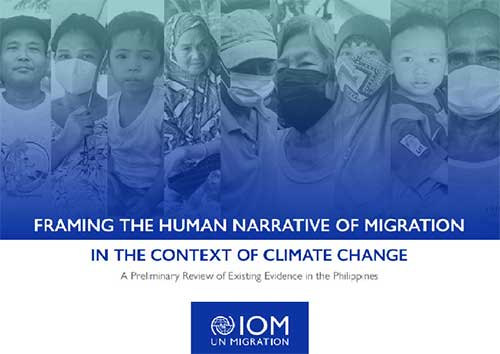
The Climate Change Commission (CCC) commits to integrate migration as a key theme in policy discourse, and to develop migrant-centered policies and programs as more and more Filipinos are forced to migrate due to the climate crisis.
A report from the International Organization for Migration (IOM) Philippines, Framing the Human Narrative of Migration in the Context of Climate Change: A Preliminary Review of Existing Evidence in the Philippines, identified farmers and fisherfolks, women, older persons, and the urban poor as the most vulnerable to climate impacts due to slow and rapid onset events, physical constraints to move, and low capacities to adapt.
The report particularly sheds light on the state of environmental migration in the Philippines, engaging the cities of Manila, Malabon, Iloilo, and Davao, as well as Samar Province, in the community consultations conducted for this report. The areas were selected due to their high exposure and vulnerability to climate impacts.
Jerome Ilagan, Chief of the CCC Policy Research and Development Division, said that “This is a long fight against the climate crisis. All institutions must unite and have the collective resolve to really ensure that across generations, we create champions from the communities. Our government is all prepared in terms of policy and programming support mechanisms and this IOM study is a policy-support decision tool. We know that the road towards resilience may be long and bumpy, but if we are together knowing that our mission is to make sure that no one is left behind, we will survive and thrive in this era of climate change.”
The report defined an environmental migrant as “persons or groups of persons who, predominantly for reasons of sudden or progressive change in the environment that adversely affects their lives or living conditions, are obliged to leave their habitual homes, or choose to do so, either temporarily or permanently, and who move either within their country or abroad.” It also provided an initial framework for in-depth policy research on climate migration, building on the existing evidence on migration and climate change in the Philippines strengthened by interviews with local governments and vulnerable sectors and communities who have been impacted.
The climate emergency worsens the already vulnerable geographic status of the Philippines and brings about more, extreme weather events, rising temperatures, sea level rise, heavy rainfall, and drought.
The physical effects of sea-level rise include inundation of low-lying areas, erosion, saltwater intrusion, increased risk of flooding, and storm surge damage. Such exposure and high vulnerability affect migration patterns in the country.
Municipalities and cities located along coastal areas are projected to be directly impacted and submerged by sea-level rise and inundation in only three decades. And according to the report, there are already 5.4 million Filipinos occupying land whose elevation is below the annual flood level.
This scenario leads to not only substantial socioeconomic losses of coastal structures, but also displacement of the population and forced shifts in livelihood sources and strategies. As people forge new ways of living, they also face increased vulnerabilities.
During the launch of the report on June 4, the CCC expressed its commitment to enhance efforts to respond to the immediate needs of affected populations while ensuring migration is utilized as a tool towards sustainable adaptation and risk mitigation for those affected by climate change.
The report, developed in partnership between IOM and CCC, can be accessed through this link:



















